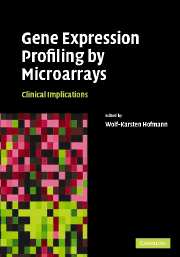Book contents
- Frontmatter
- Contents
- List of contributors
- Foreword
- Introduction
- 1 Technique of microarrays: microarray platforms
- 2 Quantitative quality control of microarray experiments: toward accurate gene expression measurements
- 3 Statistical analysis of gene expression data
- 4 Genomic stratification in patients with heart failure
- 5 Gene expression profiling for the diagnosis of acute leukemias
- 6 Gene expression profiling can distinguish tumor subclasses of breast carcinomas
- 7 Gene expression profiling in lymphoid malignancies
- 8 mRNA profiling of pancreatic beta-cells: investigating mechanisms of diabetes
- 9 Prediction of response and resistance to treatment by gene expression profiling
- Index
- References
1 - Technique of microarrays: microarray platforms
Published online by Cambridge University Press: 05 September 2009
- Frontmatter
- Contents
- List of contributors
- Foreword
- Introduction
- 1 Technique of microarrays: microarray platforms
- 2 Quantitative quality control of microarray experiments: toward accurate gene expression measurements
- 3 Statistical analysis of gene expression data
- 4 Genomic stratification in patients with heart failure
- 5 Gene expression profiling for the diagnosis of acute leukemias
- 6 Gene expression profiling can distinguish tumor subclasses of breast carcinomas
- 7 Gene expression profiling in lymphoid malignancies
- 8 mRNA profiling of pancreatic beta-cells: investigating mechanisms of diabetes
- 9 Prediction of response and resistance to treatment by gene expression profiling
- Index
- References
Summary
Introduction
Within a few years of their inception, microarrays have become a widely used tool to study global gene expression of cells in culture or complex tissues in many different organisms. The major technical advance lies in the high throughput capability covering the RNA expression of whole genomes on a single chip, thereby transforming the classical paradigm of studying “one gene at a time.” With only modest efforts, an immense amount of raw data can be produced, which has created unique challenges for the analyses and interpretations of microarray experiments when attempting to distil meaningful conclusions from these large data sets. On the experimental side, quality problems of the sample materials, on the hardware side problems with probe sets, quality controls, and protocol standardization, and on the analysis side questions of the most suitable statistical analysis techniques soon surfaced. Stringent experimental planning and controlling is necessary to extract meaningful data from microarray experiments. In order to create reliable and comparable data sets, the minimal information about a microarray experiment (MIAME) [1] has been published and adherence to these guidelines increasingly is required by scientific journals. The landscape of high-throughput gene expression has continued to evolve and most recently has witnessed an onslaught of new and improved microarray platforms.
The basic protocol starts with the hybridization of complementary strands of labeled DNA or RNA from cells or tissues with representations of known genes or expressed sequence tags (ESTs) spotted onto a solid support, usually glass or nylon.
Information
- Type
- Chapter
- Information
- Gene Expression Profiling by MicroarraysClinical Implications, pp. 8 - 26Publisher: Cambridge University PressPrint publication year: 2006
